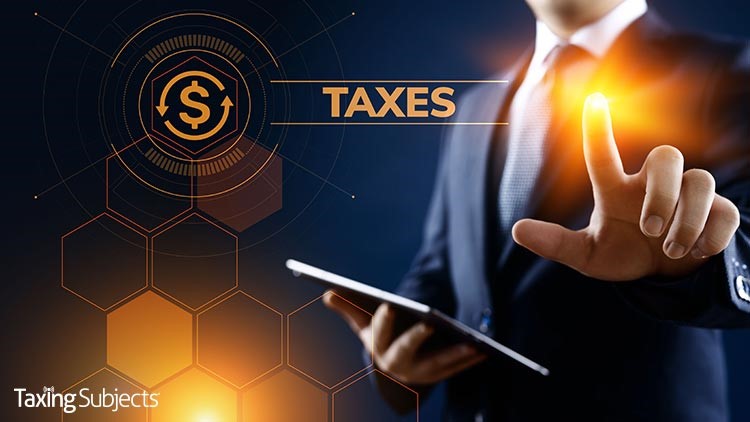by | Mar 13, 2021 | Tax Tips and News
President Biden signed into law the $1.9 trillion American Rescue Plan Act of 2021, which includes a number of tax-related provisions that lawmakers say will help struggling Americans weather the pandemic recession. As with any legislation that affects taxes, that means tax professionals need to know how it will affect their clients return preparation.
Here’s a short rundown of some of those changes.
How much are the new individual payments?
The upcoming third economic impact payment (EIP3) is an advance payment of a 2021 refundable tax credit, and it’s the most well-known component of the American Rescue Plan Act of 2021. Qualifying individuals, couples, and filers claiming dependents are expected to start receiving their payments soon:
- $1,400 for single filers with an adjusted gross income of up to $75,000
- $1,400 for heads of household with an adjusted gross income of up to $112,500
- $2,800 for married couples filing jointly with an adjusted gross income of up to $150,000
- $1,400 for each dependent, including college students and qualifying relatives who are claimed as dependents
And the credit completely zeroes out when AGI reaches the following amounts:
- $80,000 for single filers
- $120,000 for heads of household
- $160,000 for married couples filing jointly
Generally, taxpayers qualify for EIP3 if their AGI doesn’t zero out the credit and they have a valid Social Security Number. While nonresident aliens, dependents who can be claimed by another taxpayer for the 2021 calendar year, and estates and trusts will not qualify for EIP3, there are exceptions to the SSN requirement.
Married members of the Armed Forces who file jointly will receive the full $2,800 as long as one spouse has a valid Social Security Number and their AGI doesn’t start phasing out the credit. And an adoption taxpayer identification number is considered a valid identification number for qualifying dependents.
What are the tax year 2021 changes for the child tax credit?
For tax year 2021, the entire child tax credit will be refundable, and its amount will depend on the age of each qualifying child:
- Up to $3,600 for each qualifying child younger than 6
- Up to $3,000 for each qualifying child younger than 18
Previously, the child tax credit was worth up to $2,000 for qualifying children younger than 17 years, and only $1,400 of the credit was refundable.
What are the changes to the Earned Income Tax Credit?
For tax year 2021, it will be easier for more taxpayers to qualify for the earned income tax credit due to the following changes:
- The minimum age for most taxpayers to claim the credit is dropping to 19
- The minimum age for qualified former foster youths and qualified homeless youths to claim the credit is dropping to 18
- The minimum age for specified students to claim the credit is dropping to 24
- The percentage of the credit and phaseout for individuals without children is increasing to 15.3 percent
- Disqualified investment income is increasing to $10,000
- Separated spouses may qualify as an individual for purposes of the EIC if they no longer live with their spouse by the end of 2021 and have a written separation agreement or receive maintenance payments, or they are married and meet all of the following criteria:
- Does not file a joint return
- Resides with a qualifying child … for more than one-half of [tax year 2021]
- During the last 6 months of [tax year 2021], does not have the same principal place of abode as [their] spouse
- Taxpayers whose 2021 earned income is less than their 2019 earned income may instead use their 2019 information to determine the amount of the EIC
Remember, these changes only apply to tax year 2021.
What are the changes to the Premium Tax Credit?
For tax year 2020, taxpayers who received an advance payment of the premium tax credit will not have to repay any of the advance that exceeds the allowed amount when reconciling the credit on the tax return for that year.
For tax year 2021, taxpayers “who [have] received, or [have] been approved to receive, unemployment compensation for any week beginning during 2021” will be “treated as an applicable taxpayer” for the PTC.
For tax years 2021 and 2022, the premium tax credit will use the following income percentages table:
|
In the case of household income (expressed as a percent of poverty line) within the following income tier:
|
The initial premium percentage is—
|
The final premium percentage is—
|
|
Up to 150.0 percent
|
0.0
|
0.0
|
|
150.0 percent up to 200.0 percent
|
0.0
|
2.0
|
|
200.0 percent up to 250.0 percent
|
2.0
|
4.0
|
|
250.0 percent up to 300.0 percent
|
4.0
|
6.0
|
|
300.0 percent up to 400.0 percent
|
6.0
|
8.5
|
|
400.0 percent and higher
|
8.5
|
8.5
|
Note: If you already filed your taxes and reported your repayment of the Advance Premium Tax Credit (APTC), the current guidance is to wait—do not file an amended return until the IRS releases official guidance. Continue to check the News section of the IRS website for updates.
If you haven’t filed and meet the same criteria, software companies will be updating their programs once they receive guidance on the APTC from the IRS. It is advised that you should wait until software companies receive official guidance and make the necessary changes.
What are the changes to unemployment compensation?
For tax year 2020, federal income tax will be waived on unemployment compensation that doesn’t exceed $10,200 for individuals and married couples filing jointly whose adjusted gross income is less than $150,000. In the case of joint filers, the $10,200 limit applies per spouse.
For tax year 2021, unemployment benefits are extended until September 6, 2021, and starting March 31, 2021, weekly compensation will be increased by $300.
Note: If you already filed your taxes and reported unemployment benefits, the current guidance is to wait—do not file an amended return until the IRS releases official guidance. Continue to check the News section of the IRS website for updates.
If you haven’t filed and meet the same criteria, software companies are updating their programs now to include the new Unemployment Compensation Exclusion Worksheet. It is anticipated that most software companies will release updates for this new calculation during the week starting March 15.
Expect IRS guidance for provisions of the American Rescue Plan Act
The American Rescue Plan of 2021 is a sweeping recovery package that also affects the Paycheck Protection Program, paid sick and family leave, and a number of other business and individual tax credits. So, be on the lookout for Internal Revenue Service guidance for all of the legislation’s tax-related provisions in the coming weeks and months, including what’s outlined above.
Source: H.R. 1319; IRS Statement – American Rescue Plan Act of 2021
– Story provided by TaxingSubjects.com
by | Mar 12, 2021 | Tax Tips and News
The Internal Revenue Service yesterday released a COVID Tax Tip highlighting guidance for employers who deferred payment of their employee’s 2020 Social Security tax. Initially described by legislators as a “payroll tax holiday,” the agency reminds participating employers that they still have to pay deferred employee Social Security tax by the new deadlines.
The IRS explains that employers were provided payroll-related tax relief in two parts last year:
- The Coronavirus, Aid, Relief and Economic Security Act allowed employers to defer payment of the employer’s share of Social Security tax.
- IRS Notice 2020-65 allowed employers to defer withholding and payment of the employee’s Social Security taxes on certain wages paid in calendar year 2020.
Notice 2020-65 was issued by the IRS following an August 8, 2020 Presidential Memorandum that “[directed] the Secretary of the Treasury (Secretary) to use his authority pursuant to section 7508A of the Internal Revenue Code (Code) to defer the withholding, deposit, and payment of certain payroll tax obligations” (Notice 2020-65, 1).
IRS COVID Tax Tip 2021-32 addresses three important points from the notice: which employee wages qualified for deferral, when payments for deferred employee withholding are due, and how employers can pay the deferred withholding.
Which employee wages qualified for deferral under Notice 2020-65?
Employers were permitted to defer Social Security tax withholding for employees making less than $4,000 every two weeks. While private employers could voluntarily participate in the payroll tax holiday, the IRS notes in the tax tip that “it was mandatory for federal employees and military service members.”
When are payments for deferred employee withholding due?
Deferred employee withholding should be paid ratably from January 1, 2021 to December 31, 2021, though the IRS notes that, due to the holidays, December 31 payments will be considered timely as long as they’re made by January 3, 2022. Importantly, employers who miss repayment deadlines could face penalties and interest.
How do employers make deferral payments for 2020 employee withholding?
The IRS recommends the Electronic Federal Tax Payment System for making deferred employee Social Security tax payments. The system accepts credit cards, debit cards, money orders, and checks, but there is an important caveat: You have to make deferral payment separate from other payroll tax payments, since “IRS systems won’t recognize the payment if it is with other tax payments or sent as a deposit.”
That said, be on the lookout for the upcoming “deferral payment” option for EFTPS.
To make deferral payments, the IRS says “employers can visit EFTPS.gov, or call 800-555-4477 or 800-733-4829 for details.”
One final note: Business clients who elected to defer the employee Social Security withholding may want to remind affected employees that the previously deferred tax will come out of their pay in 2021, possibly resulting in lower-than-expected paychecks.
Sources: COVID Tax Tip 2021-32
– Story provided by TaxingSubjects.com
by | Mar 12, 2021 | Tax Tips and News
The Internal Revenue Service has a number of resources and accessibility services available to taxpayers who need them.
The IRS’s Alternative Media Center has tax-related content available in several formats for use with assistive technology. Available services include screen-reading software, refreshable Braille displays and screen magnifying software.
Taxpayers can visit the AMC to view and download hundreds of tax forms and publications in alternative formats such as:
- Text-only
- Braille ready files
- Browser-friendly HTML
- Accessible PDF
- Large print PDF
The IRS says the content of the Alternative Media Center is not static; they are working to make its resources as accessible as possible. However, not every product is available in every format.
For example, tax forms are not available as HTML.
The AMC operates a facility to produce interpoint Braille and large-print pages. The AMC also has Braille transcriptionists who use translation software to provide customized translation services.
Getting accessible tax products
People who need accessible tax forms, instructions or publications can download them from the Accessible Forms and Publications page of IRS.gov, or call 800-TAX-FORM (800-829-3676) to request copies.
A taxpayer who gets an IRS notice or letter can request it in Braille or large print. There are three basic options:
- Call the IRS at 800-829-1040.
- Fax the notice with a cover sheet to the AMC at 855-473-2006. The cover sheet should include their name, address, phone number and the desired format of the document. Write “Alternative Media Format” at the top of the cover page.
- Mail the notice or letter with a note stating the preferred format to:
IRS Alternative Media Center
400 N. 8th St., Room G39
Richmond, VA 23219
Once the AMC receives a notice it will take up to 15 business days to convert and mail it back.
The IRS is planning ahead
The IRS is developing a process to make it easier for visually impaired taxpayers to request post-filing tax notices in Braille, large print, audio or electronic formats. These offerings will include notices about additional taxes or penalties owed.
The agency expects the new process will be in place by Jan. 31, 2022.
The IRS is also creating an Accessibility Helpline to answer questions related to current and future accessibility services and alternative media formats available to taxpayers with disabilities.
File a complaint
The IRS says its Office of Equity, Diversity and Inclusion (EDI), Civil Rights Division “upholds and protects the civil rights of all taxpayers, including individuals with disabilities or limited English proficiency.”
Taxpayers who have experienced discrimination during an IRS-conducted program or by an IRS staff member or volunteer should address their complaint or issue using the Accessibility Helpline when it comes available, or submit a complaint in writing using Form 14652, Civil Rights Complaint, to:
Director, IRS Civil Rights Division
Room 2413
1111 Constitution Avenue, NW
Washington, DC 20224
Contact EDI at this mailing address for all other inquiries concerning taxpayer civil rights, or send an email to edi.civil.rights.division@irs.gov.
Sources: IRS provides resources and services for visually impaired taxpayers; Information About the Alternative Media Center
– Story provided by TaxingSubjects.com
by | Mar 11, 2021 | Tax Tips and News
It’s tax season, and that means you’re as busy as you can be. But it’s also the busy season for crafty criminals: scammers impersonating the IRS, either over the phone, by email or in person. Any of these methods can be used to steal money from people.
All taxpayers—and their trusted tax professionals—should stay vigilant against these schemes.
The Internal Revenue Service has released a list of tips to help people recognize and avoid tax-related scams.
While most of these tips are aimed at taxpayers, today’s tax pros take security seriously, so their clients should, too. Besides, when taxpayers are targeted by one of these scams, many times their tax preparer is the first one they call.
Help them be prepared.
Email Phishing Scams
Help your clients remember that the IRS does not initiate contact with taxpayers by email to seek personal or financial information. In most cases, the IRS first mails a paper bill to a person who owes taxes. In some special situations, the IRS will call or come to a home or business.
IRS-, Treasury-, or tax-related suspicious online or email phishing scams should be reported to phishing@irs.gov. Recipients should not open any attachments, click on any links, reply to the sender or take any other actions that could put them at risk.
Telephone Scams
As we mentioned, the IRS generally first mails a bill to a taxpayer who owes taxes. There are specific ways to pay taxes.
Scammers frequently exhibit behavior that the real IRS and its authorized private collection agencies just won’t allow, thus showing themselves to be imposters.
The IRS and its private collection agencies will not:
- Leave pre-recorded, urgent, or threatening messages on an answering system.
- Threaten to immediately bring in local police or other law enforcement groups to arrest the taxpayer for not paying, deport them, or revoke their licenses.
- Call to demand immediate payment with a prepaid debit card, gift card or wire transfer.
- Ask for checks to third parties.
- Demand payment without giving the taxpayer an opportunity to question or appeal the amount owed.
Remind your taxpayers that these criminals can fake or spoof caller ID numbers that appear to be from anywhere in the country. The scammers can even spoof an IRS office phone number or the numbers of various local, state, federal or tribal government agencies.
If a taxpayer gets an IRS- or Treasury-related phone call, but doesn’t owe taxes and has no reason to think they do, they should NOT give out any information, and hang up immediately.
Next, contact the Treasury Inspector General for Tax Administration to report the IRS impersonation scam call.
Report the caller ID and callback number to the IRS by sending it to phishing@irs.gov. Include “IRS Phone Scam” in the subject line of the email.
Lastly, they should report the call to the Federal Trade Commission.
If your taxpayer clients want to verify what taxes they owe to the IRS they should view tax account information online at IRS.gov and review their payment options.
Sources: Tips to help taxpayers spot and avoid tax scams
– Story provided by TaxingSubjects.com
by | Mar 10, 2021 | Tax Tips and News
The dates for the 2021 Nationwide Tax Forum have been set. But before you start calling for airline tickets, the announcement from IRS Commissioner Chuck Rettig has some helpful advice about travel plans:
“Like many of you, we look forward to resuming the IRS Tax Forum in-person events once we can safely do so. However, due to ongoing and evolving public health and safety concerns resulting from the COVID-19 health emergency, the 2021 IRS Nationwide Tax Forum and Expo will once again be offered virtually,” Rettig says.
This year’s Virtual Tax Forum will be held beginning July 20, and includes live webinars every Tuesday, Wednesday, and Thursday. The list of topics and program schedule will be released in early April.
In the meantime, IRS Commissioner Rettig has released a YouTube video on open registration for the event. In the video, the commissioner stresses that for now, the event remains a virtual affair.
“We’ve been working hard to ensure the IRS Nationwide Tax Forum program provides the information and services you need,” Rettig says. “I’m confident you’ll find this format just as informative as the in-person sessions and will enjoy the experience.”
To register, visit www.irstaxforum.com.
Held each summer for the past 30 years, the IRS Nationwide Tax Forums are the IRS’s signature outreach event to the tax professional community. In years past, the forums have been scheduled to take place in six cities around the country each summer.
For 2021, the IRS Nationwide Tax Forums will be held in a virtual environment with a series of live-streamed webinars and other online events.
What are the benefits of the Virtual Tax Forums?
Why attend this year’s Virtual Tax Forum? It’s a great opportunity to:
- Learn and earn CE credits from the comforts of home;
- Hear the latest updates on tax law, cybersecurity, ethics, and more;
- Get reliable information directly from the IRS;
- Visit the industry-leading vendors at the Virtual Expo; and
- Share experiences and discuss innovative ideas with the IRS through focus groups.
Tax pros who want to earn continuing education at the Virtual Tax Forums need to make sure they satisfy the three requirements outlined in the “Earning CE Credits” section of IRSTaxForum.com:
- Be present for the entire 60-minute presentation
- Respond to all polling questions throughout the presentation
- Complete the survey at the end of the presentation
That said, there is an important limitation for certain topics: “In cases where the same subject matter is presented in English and Spanish, the webinar will only qualify for one CE credit even if you participate in both the English and Spanish versions.”
When can I register for the IRS 2021 Nationwide Tax Forums?
Early registration for the 2021 Nationwide Tax Forums runs through June 15, and carries an Early Bird Rate of $240 per person. After June 15, the signup rate rises to $289.
Come see Drake Software at the Virtual Expo!
Drake Software will once again take part in the Virtual Expo, so be sure to visit our virtual booth!
Sources: IRS Nationwide Tax Forum Information; 2021 IRS Tax Forum Will Be Virtual; IRS Nationwide Tax Forum 2021; Annual Filing Season Program
– Story provided by TaxingSubjects.com





